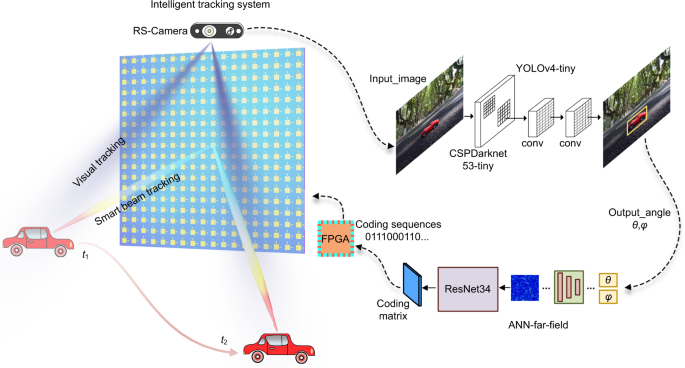Time: 2025-02-14 11:40:58View:
This project aims to implement a real-time multi-target image recognition and tracking system using a high-end FPGA. The core algorithm is based on frame difference, which is a lightweight and efficient method for motion detection and object tracking. The system will process video streams, detect moving objects, and track them across frames.

1. Frame Difference Algorithm:
Compute the absolute difference between consecutive video frames.
Threshold the difference to identify moving objects.
Use morphological operations (e.g., dilation, erosion) to reduce noise and improve object detection.
2. Multi-Target Detection:
Identify and label multiple objects in the frame.
Use connected component analysis or clustering algorithms to separate objects.
3. Target Tracking:
Assign unique IDs to detected objects.
Use motion vectors or centroid tracking to follow objects across frames.
Handle object occlusion and reappearance.
4. FPGA Implementation:
Leverage FPGA parallelism for real-time processing.
Use hardware-optimized modules for frame difference, thresholding, and morphological operations.
Implement memory-efficient data structures for tracking.
1. Input Interface:
Receive video stream from a camera (e.g., HDMI, MIPI, or GigE Vision).
Preprocess frames (e.g., grayscale conversion, resizing).
2. Frame Difference Module:
Compute pixel-wise difference between consecutive frames.
Apply a threshold to generate a binary motion mask.
3. Noise Reduction Module:
Use morphological operations to clean up the motion mask.
Remove small noise regions and fill gaps in detected objects.
4. Object Detection and Labeling:
Identify connected components in the motion mask.
Assign unique labels to each detected object.
5. Tracking Module:
Calculate centroids of detected objects.
Match objects across frames using distance metrics (e.g., Euclidean distance).
Update object positions and handle ID assignments.
6. Output Interface:
Overlay tracking results (e.g., bounding boxes, IDs) on the video stream.
Output processed video to a display or storage device.
1. Parallelism:
Exploit FPGA parallelism for pixel-level operations (e.g., frame difference, thresholding).
Use pipelining to ensure high throughput.
2. Memory Management:
Store frames in on-chip BRAM or external DDR memory.
Optimize memory access patterns to reduce latency.
3. Resource Utilization:
Use DSP slices for arithmetic operations.
Optimize logic usage for morphological operations and connected component analysis.
4. Real-Time Performance:
Ensure the design meets the required frame rate (e.g., 30 FPS or higher).
Minimize latency between input and output.
1. FPGA Platform:
Xilinx Virtex UltraScale+ or Intel Stratix 10 for high-end performance.
Development boards like Xilinx ZCU102 or Intel Arria 10 GX.
2. Development Tools:
Xilinx Vivado or Intel Quartus for FPGA design.
High-Level Synthesis (HLS) tools for algorithm acceleration.
3. Programming Languages:
Verilog or VHDL for RTL design.
C/C++ for HLS-based algorithm development.
4. Libraries:
OpenCV for algorithm prototyping and verification.
Xilinx Vitis Vision or Intel OpenVINO for FPGA-optimized vision libraries.
1. Algorithm Development:
Prototype the frame difference and tracking algorithm in Python/OpenCV.
Validate the algorithm on sample video data.
2. FPGA Implementation:
Convert the algorithm to hardware using HLS or RTL.
Optimize the design for FPGA resources and performance.
3. Simulation and Testing:
Simulate the design using testbenches.
Verify functionality with synthetic and real-world video data.
4. Deployment:
Program the FPGA with the final design.
Integrate with a camera and display for real-time testing.
1. Real-Time Processing:
Challenge: High frame rates require low-latency processing.
Solution: Optimize pipeline stages and use parallel processing.
2. Resource Constraints:
Challenge: Limited FPGA resources for complex algorithms.
Solution: Use efficient data structures and approximate computations.
3. Occlusion Handling:
Challenge: Objects may disappear and reappear due to occlusion.
Solution: Implement robust tracking algorithms (e.g., Kalman filters).
4. Noise and False Positives:
Challenge: Environmental noise can lead to false detections.
Solution: Use adaptive thresholding and advanced noise reduction techniques.
1. Surveillance Systems:
Real-time tracking of multiple objects in security cameras.
2. Autonomous Vehicles:
Detection and tracking of pedestrians, vehicles, and obstacles.
3. Robotics:
Object tracking for navigation and manipulation.
4. Traffic Monitoring:
Vehicle detection and tracking for traffic analysis.
1. Machine Learning Integration:
Use neural networks for object classification and improved tracking.
2. Multi-Camera Support:
Extend the system to handle multiple camera inputs for wider coverage.
3. 3D Tracking:
Incorporate depth information for 3D object tracking.
4. Energy Optimization:
Reduce power consumption for battery-powered applications.
This project demonstrates the power of FPGAs for real-time image processing and tracking, making it suitable for high-performance applications in computer vision and embedded systems.